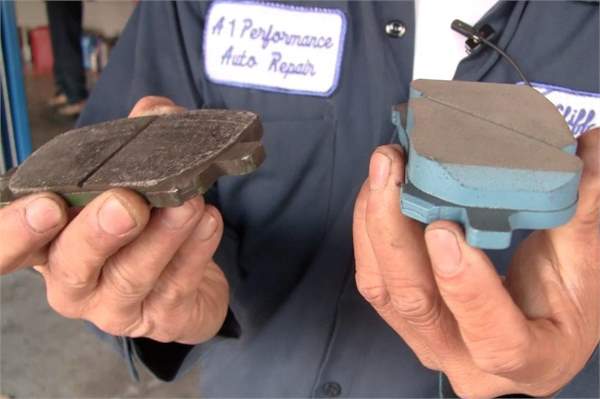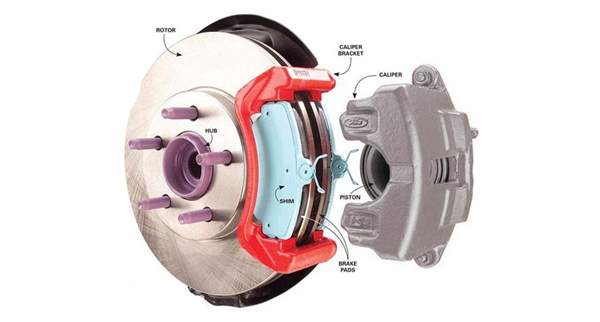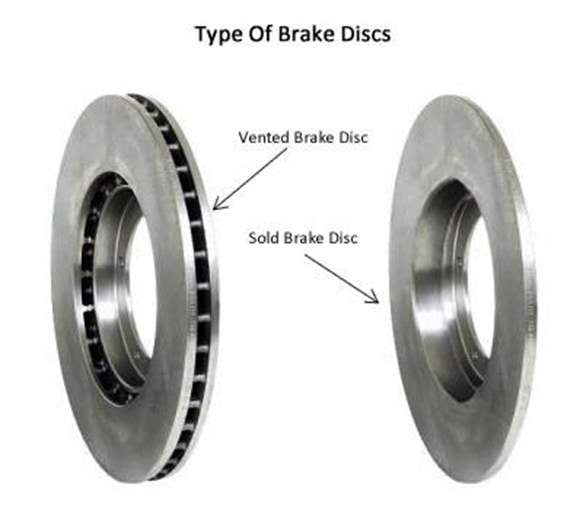The Importance of Brake Discs
Braking components are one of the most important parts of any vehicle and they should be checked on a regular basis. Worn brake components can result in reduced braking ability and increased stopping distances leading directly to a greater risk of having an accident.
How to know when to replace your brake discs
There are 5 main warning signs that indicate your brakes are worn or damaged.
1. A high pitched or grinding noise when you apply the brakes.

(Some pads have warning indicators that make this sound to alert the driver when the friction material is low.)
2. An unusual vibration during braking.
(This normally indicates a warped brake disc which has the potential to lead to a loss in brake performance.)
3. The brake pedal feels softer to press than usual.
(Air or moisture may have contaminated the brake fluid causing extended pedal travel.)
4. The distance it takes for the car to slow down or come to a complete stop during braking has increased.
(Worn brake pads or discs can result in an increased stopping distance during braking.)
5. The vehicle pulls to one side when braking.
(Sticky calipers can cause the vehicle to pull to one side and lead to a reduction in braking performance.)
How do brake systems work?
The majority of brake systems are simple. At each wheel you have a brake disc, brake caliper and a pair of brake pads. When you press the brake pedal, brake fluid is forced to the caliper which then squeezes the brake pads against the brake disc thus slowing the vehicle down.

How to check the condition of your brake discs and pads
You do not have to remove the wheel of the car to visually inspect the brake discs. However, for a visual inspection of the brake pads you will need to remove the wheel.
Brake Discs
The side of the brake disc facing you should have a shiny exterior. The main things to look out for are rough spots or visible grooves. This usually indicates that the brake disc is beyond its minimum thickness and it should be replaced.
Brake Pads
Turning the steering wheel in the opposite direction of the brake pads you are inspecting can offer a better view. The pads will be facing the brake disc and they are enclosed by the brake calipers, normally there will be an inspection hole so the thickness can be checked. Brake pads should be replaced if the pad is less than 1/8th of an inch in thickness (this is approximately the thickness of two cent coins stacked on top of one another).
How to choose the correct brake discs for your vehicle
While at MicksGarage we try to narrow down the brake pads and discs for customers vehicles with our registration number look up (reg-look up) or car drop down options. These systems may not be able to provide enough information to narrow down the results to the exact type of brakes discs for your vehicle.
Customers will be offered all of the brake pads for their make and model but the correct items may need to be picked from the range listed. For example: Two Audi A3’s of the same year and engine size may require different types of brake discs. These differences can come down to what factory the vehicle was built in or what extra features it has.
The best way to ensure you get the correct brake discs is to check the diameter of the brake discs already fitted. The diameter and thickness of the disc is illustrated below. To measure the diameter you may not have to remove the wheel, however it would make the measuring process easier. You may also want to record this size for future reference. After checking diameter of your own brake disc, use it as a reference to the sizes quoted on our website.

The following information is also important for selecting the correct brake pad.
Brake Disc Thickness : For accurate measurements use a digital micrometer, a measuring tape can also be used.
Fitting Position: This is the position of the brake disc, it will either be for the front or rear axle.
Diameter: This is the diameter of the brake disc.
Number of Holes: This corresponds to the number of bolts on the wheel. If the wheel has four bolts then you would need brake discs with four holes in it.
Pitch Circle : The pitch circle or pitch circle is the notional circle determined by the positions of the bolts. The centre of every bolt lies on the circumference of the bolt circle.
Wheel Hub Diameter : The hub diameter will be the size of the center hole of the disc or the diameter of hub where the disc is fitted too.
Brake Disc Type:
There are two main types of brake discs: Vented & Solid

These two types of discs are easy to tell apart if you look at them from the side. If you have alloy wheels with reasonable space between the spokes you will probably be able to tell if your brake discs are solid or vented without even taking the wheel off.
Vented brakes discs, are two flat discs put together, one on top of the other, with gaps between them to allow air flow. This helps the discs stay cool and improves braking and extends the life of the discs.
Solid discs are just that, a solid disc with no space between them. See picture.
How to choose the correct brake pads for your vehicle.
The best and easiest way to ensure you get the correct pads is to check the shape and size of the pad already fitted. This may be time consuming but it will ensure you get the correct brake pad. With brake pads we always offer an accurate image along with the relevant sizes, the image and size should be a perfect match to the pads on your vehicle. If multiple dimensions of the brake pad are shown, measuring your brake pad will ensure you select the correct one. The image below illustrates the dimensions of a brake pad.

The following information is also important for selecting the correct brake pad.
Fitting Position: This is the position of the brake pad, it will either be for the front or rear axle.
Brake System: These are the manufacturers of the brake pads, if more than one manufacturer is shown when you have a car selected you will need to check your brakes for the brake system of the pad fitted.
Wear Warning Contact: A Brake wear indicator also known as a wear warning contact is used to warn the driver of the vehicle that the brake pad is in need of replacement. If your brake pads have wear warning contact system then you must select a brake pad that has this function.
To Construction Year: Some brake pads only fit a vehicle up until a certain time period.
Start your search for Brake Discs by clicking here or for Brake Pads by clicking here.